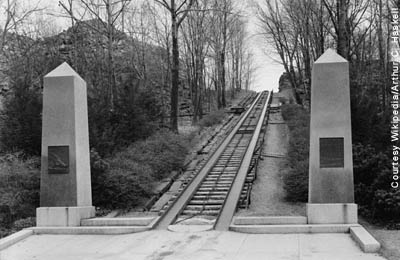Granite Railway
42 14 43.0 N
71 02 14.0 W

The Granite railway, a unique project that first demonstrated the engineering advantages of rail transport in America, introduced many technical features such as switches, the turntable and the double-truck railway car.
"I finally received a charter [to build the railway], although there was great opposition in the House. The questions were asked, 'What do we know about railroads? Who ever heard of such a thing? Is it right to take people's land for a project that no one knows anything about?' Such and similar objections were made and onerous restrictions were imposed, but it finally passed by a small majority only."
- Gridley Bryant, 1871
The Granite Railway Company of Quincy was the first commercial railway in the United States. Incorporated in 1826 and designed by Gridley Bryant, the railway relied on horses, rather than steam locomotives, to draw the cars along the tracks. Its primary purpose was to transport granite from Quincy to build the Bunker Hill Monument.
A section of the railway called the Incline was added in 1830 to haul granite from the Pine Ledge quarry to the railway level 84 feet below. Cars moved up and down the 315-foot incline, controlled by an endless conveyor belt-type chain. The Incline continued to operate until the 1940s.
The four-mile railway introduced a variety of rail system innovations, including switches, the turntable, and double-truck railway cars. This primitive railway helped inaugurate the great era of American railroad building.
Facts
- This innovative use of rails met with considerable skepticism as canals were then considered the optimum mode of transportation.
- The project began on April 1 and was completed by October 7, a mere six months.
- Bryant designed a swing platform to receive loaded cars at the base of the inclined plane. The platform was balanced by weights and used gears to dump loads and return the vehicles to a horizontal position.
- To construct the road, stone sleepers were laid across the roadbed, eight feet apart. Six-inch-thick wooden rails were placed over the sleepers, then iron plates were fastened to the rails with spikes.

